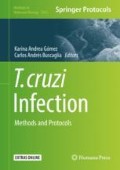Abstract
RNA-seq is a powerful method to study in detail transcriptome changes in defined conditions, providing enormous amount of information on RNA stability and gene regulation. In this chapter, we describe a directional and a nondirectional library preparation protocol for RNA-seq in Trypanosoma cruzi, as well as a pipeline for bioinformatic analysis, which includes read trimming, alignment to a reference genome, and differential expression.
Access this chapter
Tax calculation will be finalised at checkout
Purchases are for personal use only
References
El-Sayed NM, Myler PJ, Bartholomeu DC et al (2005) The genome sequence of Trypanosoma cruzi, etiologic agent of chagas disease. Science 309(5733):409–415. https://doi.org/10.1126/science.1112631
Berná L, Rodríguez M, Chiribao ML et al (2018) Expanding an expanded genome: long-read sequencing of Trypanosoma cruzi. Microb Genom 4:279174. https://doi.org/10.1101/279174
Berná L, Chiribao ML, Greif G et al (2017) Transcriptomic analysis reveals metabolic switches and surface remodeling as key processes for stage transition in trypanosoma cruzi. PeerJ 2017:e3017. https://doi.org/10.7717/peerj.3017
Li Y, Shah-Simpson S, Okrah K et al (2016) Transcriptome remodeling in Trypanosoma cruzi and human cells during intracellular infection. PLoS Pathog 12:e1005511. https://doi.org/10.1371/journal.ppat.1005511
Contreras VT, Araujo-Jorge TC, Bonaldo MC et al (1988) Biological aspects of the Dm 28c clone of Trypanosoma cruzi after metacyclogenesis in chemically defined media. Mem Inst Oswaldo Cruz 83(1):123–133. https://doi.org/10.1590/S0074-02761988000100016
Andrews S (2013) FastQC: a quality control tool for high throughput sequence data. Available online at: http://www.bioinformatics.babraham.ac.uk/projects/fastqc
Joshi N, Fass J (2011) Sickle: a sliding-window, adaptive, quality-based trimming tool for FastQ files (Version 1.33) [Software]. Available at https://github.com/najoshi/sickle 2011
Langmead B, Trapnell C, Pop M, Salzberg SL (2009) Ultrafast and memory-efficient alignment of short DNA sequences to the human genome. Genome Biol 10:R25. https://doi.org/10.1186/gb-2009-10-3-r25
Mortazavi A, Williams BA, McCue K et al (2008) Mapping and quantifying mammalian transcriptomes by RNA-Seq. Nat Methods 5:621–628. https://doi.org/10.1038/nmeth.1226
Love MI, Huber W, Anders S (2014) Moderated estimation of fold change and dispersion for RNA-seq data with DESeq2. Genome Biol 15:550–571. https://doi.org/10.1186/s13059-014-0550-8
Chomczyński P, Sacchi N (1987) Single-step method of RNA isolation by acid guanidinum thiocyanate-phenol-chlotoform extraction. Anal Biochem 162:156–159
Kessler RL, Pavoni DP, Krieger MA, Probst CM (2017) Trypanosoma cruzi specific mRNA amplification by in vitro transcription improves parasite transcriptomics in host-parasite RNA mixtures. BMC Genomics 18:793–808. https://doi.org/10.1186/s12864-017-4163-y
Pastro L, Smircich P, Di Paolo A et al (2017) Nuclear compartmentalization contributes to stage-specific gene expression control in Trypanosoma cruzi. Front Cell Dev Biol 5:8. https://doi.org/10.3389/fcell.2017.00008
Cope L (2009) Discussion of: Browninan distance covariance. Ann Appl Stat 3:1279–1281. https://doi.org/10.1214/09-AOAS312F
Belew AT, Junqueira C, Rodrigues-Luiz GF et al (2017) Comparative transcriptome profiling of virulent and non-virulent Trypanosoma cruzi underlines the role of surface proteins during infection. PLoS Pathog 13:e1006767. https://doi.org/10.1371/journal.ppat.1006767
Chávez S, Eastman G, Smircich P et al (2017) Transcriptome-wide analysis of the Trypanosoma cruzi proliferative cycle identifies the periodically expressed mRNAs and their multiple levels of control. PLoS One 12:e0188441. https://doi.org/10.1371/journal.pone.0188441
García-Huertas P, Mejía-Jaramillo AM, González L, Triana-Chávez O (2017) Transcriptome and functional genomics reveal the participation of adenine phosphoribosyltransferase in Trypanosoma cruzi resistance to benznidazole. J Cell Biochem 118:1936–1945. https://doi.org/10.1002/jcb.25978
Kolev NG, Ullu E, Tschudi C (2014) Construction of Trypanosoma brucei Illumina RNA-seq libraries enriched for transcript ends. In: Parasite genomics protocols, 2nd edn. Humana, New York, pp 165–175
Kolev NG, Franklin JB, Carmi S et al (2010) The transcriptome of the human pathogen Trypanosoma brucei at single-nucleotide resolution. PLoS Pathog 6:e1001090. https://doi.org/10.1371/journal.ppat.1001090
Mulindwa J, Fadda A, Merce C et al (2014) Methods to determine the transcriptomes of trypanosomes in mixtures with mammalian cells: the effects of parasite purification and selective cDNA amplification. PLoS Negl Trop Dis 8:e2806. https://doi.org/10.1371/journal.pntd.0002806
Nilsson D, Gunasekera K, Mani J et al (2010) Spliced leader trapping reveals widespread alternative splicing patterns in the highly dynamic transcriptome of Trypanosoma brucei. PLoS Pathog 6:21–22. https://doi.org/10.1371/journal.ppat.1001037
Jackson AP, Goyard S, Xia D et al (2015) Global gene expression profiling through the complete life cycle of Trypanosoma vivax. PLoS Negl Trop Dis 9:e0003975. https://doi.org/10.1371/journal.pntd.0003975
Author information
Authors and Affiliations
Corresponding author
Editor information
Editors and Affiliations
1 Electronic Supplementary Material
Supplementary Material 1
Transcripts abundance quantification using Erange (PDF 228 kb)
Supplementary Material 2
DESeq pipeline (DOCX 14 kb)
Rights and permissions
Copyright information
© 2019 Springer Science+Business Media, LLC, part of Springer Nature
About this protocol
Cite this protocol
Greif, G., Berná, L., Díaz-Viraqué, F., Robello, C. (2019). Transcriptome Studies in Trypanosoma cruzi Using RNA-seq. In: Gómez, K., Buscaglia, C. (eds) T. cruzi Infection. Methods in Molecular Biology, vol 1955. Humana Press, New York, NY. https://doi.org/10.1007/978-1-4939-9148-8_3
Download citation
DOI: https://doi.org/10.1007/978-1-4939-9148-8_3
Published:
Publisher Name: Humana Press, New York, NY
Print ISBN: 978-1-4939-9147-1
Online ISBN: 978-1-4939-9148-8
eBook Packages: Springer Protocols

